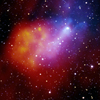CXC Home | Search | Help | Image Use Policy | Latest Images | Privacy | Accessibility | Glossary | Q&A
Tour of G327.1-1.1
Quicktime MPEG
G327.1-1.1 is the aftermath of a massive star that exploded as a supernova in the Milky Way galaxy. A highly magnetic, rapidly spinning neutron star called a pulsar was left behind after the explosion and is producing a wind of relativistic particles, seen in X-rays by Chandra and XMM-Newton as well as in radio data. This structure is called a pulsar wind nebula. No clear explanation is yet known for the unusual shape of this supernova remnant. One possibility is that we are seeing the effects of a shock wave bouncing backwards off of the shell of material swept up by the blast wave. The X-ray observations allow scientists to estimate the energy released during the supernova explosion and the age of the remnant, as well as the amount of material being swept up as the blast wave from the explosion expands.
[Runtime: 1:08]
Quicktime MPEG
G327.1-1.1 is the aftermath of a massive star that exploded as a supernova in the Milky Way galaxy. A highly magnetic, rapidly spinning neutron star called a pulsar was left behind after the explosion and is producing a wind of relativistic particles, seen in X-rays by Chandra and XMM-Newton as well as in radio data. This structure is called a pulsar wind nebula. No clear explanation is yet known for the unusual shape of this supernova remnant. One possibility is that we are seeing the effects of a shock wave bouncing backwards off of the shell of material swept up by the blast wave. The X-ray observations allow scientists to estimate the energy released during the supernova explosion and the age of the remnant, as well as the amount of material being swept up as the blast wave from the explosion expands.
[Runtime: 1:08]
(Credits: X-ray: NASA/CXC/SAO/T.Temim et al. and ESA/XMM-Newton Radio: SIFA/MOST and CSIRO/ATNF/ATCA; Infrared: UMass/IPAC-Caltech/NASA/NSF/2MASS)
Return to G327.1-1.1 (October 5, 2010)



